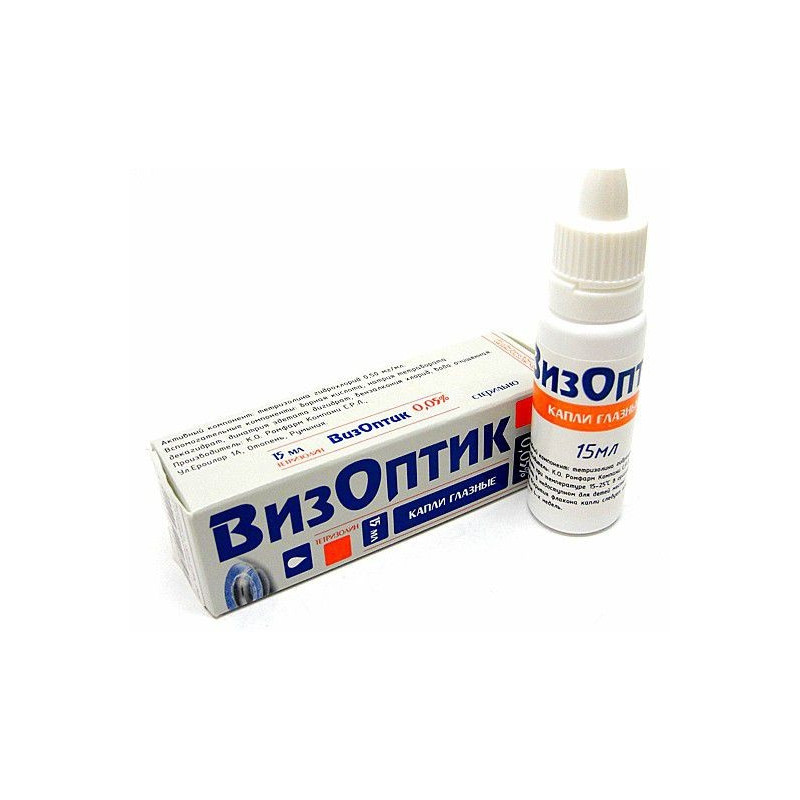



 All payments are encrypted via SSL
All payments are encrypted via SSL
 Full Refund if you haven't received your order
Full Refund if you haven't received your order
- mild eye irritation: itching, swelling and hyperemia of the conjunctiva, burning, tearing, scleral injection caused by chemical and physical factors (dust, cosmetics, swimming in chlorinated water, the action of bright light or radiation from a computer monitor);
- allergic conjunctivitis.
Adults and children over 3 years instill 1-2 drops 2-3 times / day in the lower conjunctival sac of the affected eye.
If within 48 hours the improvement does not occur, the further use of the drug should be discontinued and consult a doctor.
Local reactions: increased intraocular pressure, burning sensation and reactive hyperemia of the eye; rarely - pupil dilation.
Systemic reactions: increased blood pressure, hyperglycemia, impaired heart function, headache, nausea, drowsiness, weakness, tremor, dizziness, insomnia, tachycardia, allergic reactions.
- glaucoma;
- endothelial epithelial dystrophy of the cornea;
- acute cardiovascular insufficiency;
- bacterial infection of the eye;
- foreign body of the eye;
- children's age up to 3 years;
- hypersensitivity to the drug.
WITH caution The drug should be used for arterial hypertension, arrhythmia, aneurysm, hyperthyroidism, pheochromocytoma, diabetes mellitus, severe organic heart and vascular diseases (including CHD), as well as during treatment with MAO inhibitors and other drugs that increase blood pressure.
The use of the drug during pregnancy and lactation (breastfeeding) is possible only if the intended benefit to the mother outweighs the risk to the fetus or child.
Contraindicated in children under 3 years.
Visoptic is advisable to use only with mild eye irritation. If irritation and hyperemia of the conjunctiva are associated with an infectious disease, the presence of a foreign body or chemical corneal trauma, consult an eye specialist.
If within 48 hours after the start of the use of eye drops, the symptoms of the disease persist, become more pronounced or show side effects, you should stop using the drug and consult with an eye specialist.
In case of intense pain in the eyes, headache, blurred vision, sudden appearance of "floating spots" in front of the eyes, red eyes, pain when exposed to light or double vision, you should immediately consult a doctor.
When wearing contact lenses they are removed before instillation of the drug and re-set 15 minutes after it. It is necessary to avoid direct contact of eye drops with soft contact lenses due to a possible violation of their transparency.
The drug should not be used simultaneously with MAO inhibitors (including phenelzine, nialamide, iproniazid) and for 10 days after stopping their administration.
Influence on ability to drive motor transport and control mechanisms
During the period of treatment, care must be taken when driving vehicles and engaging in other potentially hazardous activities that require increased concentration, psychomotor speed and good vision (after using eye drops, pupil dilation and blurred vision may occur).
The development of systemic symptoms of overdose is possible with the accidental or deliberate ingestion of the drug inside or overdosing with local use.
Symptoms: pupil dilation, nausea, cyanosis, fever, convulsions, arrhythmias, arterial hypertension, pulmonary edema, dyspnea. Excessive systemic absorption of imidazole derivatives can lead to CNS depression, accompanied by drowsiness, hypothermia, bradycardia, collapse, apnea, and coma.
The risk of overdose symptoms associated with the absorption of the drug is high in young children, especially if swallowed.Overdose in children can manifest depression of the central nervous system, accompanied by drowsiness, excessive sweating, severe hypotension, up to shock.
Treatment: they prescribe Activated carbon, gastric lavage, oxygen inhalation, use of antipyretic and anticonvulsant drugs. Phentolamine 5 mg by 0.9% sodium chloride solution slowly in / in or 100 mg orally is used to reduce blood pressure. The specific antidote is unknown.
Simultaneous use with MAO inhibitors, tricyclic antidepressants, guanetidinum can cause arterial hypertension, tachycardia.
Simultaneous use with reserpine, insulin, propranolol, general anesthetics, atropine increases the risk of cardiovascular effects of tetrizolin.
Simultaneous use with guanethidine can provoke mydriasis with temporary visual impairment.
The drug should be stored out of the reach of children at a temperature of 15 ° to 25 ° C.
